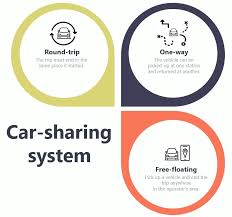In recent years, ride-sharing and car-sharing services have emerged as a popular alternative to traditional modes of transportation. These services, which allow individuals to rent or share a vehicle with others for a short period of time, have changed the way people think about mobility and have had a significant impact on the transportation industry.
Ride-sharing services
Also known as transportation network companies, have become particularly popular in urban areas where traffic congestion and limited parking make owning a car less appealing. Companies like Uber and Lyft have disrupted the traditional taxi industry by offering on-demand, app-based ride services that are often cheaper and more convenient than traditional taxis. These companies also offer a wider range of services, including luxury rides, carpooling, and food delivery, making them a one-stop-shop for a variety of transportation needs.
One of the biggest benefits of ride-sharing services is their flexibility. Riders can request a ride at any time of day or night, and drivers can choose when and where they want to work. This means that people who work irregular hours or need to travel at odd times can still find a ride when they need it.
Another advantage of ride-sharing services is their affordability. Many people find that using a ride-sharing service is cheaper than owning a car, especially in urban areas where parking can be expensive and public transportation may not be convenient. In addition, ride-sharing companies often offer promotions and discounts that can make their services even more affordable.
Car-sharing services
Allow individuals to rent a vehicle for a short period of time, usually by the hour or day. This allows people to have access to a car when they need it, without the expense and hassle of owning a vehicle. Companies like Zipcar and Car2Go have made car-sharing services more accessible, with vehicles parked in designated spots throughout cities that can be reserved and unlocked using a smartphone app.
Car-sharing services are especially popular with urban dwellers who may not need a car on a daily basis but occasionally require one for longer trips or errands. By renting a car only when they need it, these individuals can save money on insurance, maintenance, and other costs associated with car ownership.
Car-sharing services also have environmental benefits, as they can reduce the number of cars on the road and promote the use of more fuel-efficient vehicles. In addition, car-sharing companies often have partnerships with public transportation providers, allowing users to easily combine different modes of transportation for their journeys.
While ride-sharing and car-sharing services have numerous benefits, they also face a number of challenges. One of the biggest concerns is safety, as drivers and vehicles may not be subject to the same regulations and standards as traditional taxi and rental car services. Many ride-sharing companies have implemented background checks and vehicle inspections to address these concerns, but accidents and incidents still occur.
Another challenge for ride-sharing and car-sharing services is regulatory uncertainty. In many jurisdictions, these services are still subject to a patchwork of regulations that can vary from city to city and even from one neighborhood to another. This can make it difficult for companies to operate and for consumers to understand their rights and responsibilities.

Finally, there is concern that ride-sharing and car-sharing services could contribute to increased traffic congestion and reduced use of public transportation. While these services can be a convenient alternative to driving, they may also encourage more people to use private vehicles instead of walking, cycling, or taking public transportation. In addition, some experts have warned that ride-sharing services could lead to a decline in the use of public transportation, as people may see these services as a more convenient and affordable option.
Despite these challenges, ride-sharing and car-sharing services are likely to continue to grow in popularity and influence in the coming years. As more people become aware of the benefits of these services, and as technology improves to make them more efficient and convenient,
They will likely become an even more integral part of the transportation landscape.
In addition, there is the potential for ride-sharing and car-sharing services to be integrated with other modes of transportation, such as public transit and bike-sharing programs. This could create a more seamless and efficient transportation network, allowing individuals to easily switch between different modes of transportation depending on their needs and preferences.
Overall, the emergence of ride-sharing and car-sharing services has had a significant impact on the transportation industry, offering a more flexible, affordable, and convenient alternative to traditional modes of transportation. While these services face challenges in terms of safety, regulation, and environmental impact, they also offer tremendous opportunities for innovation and collaboration in the transportation sector.
As ride-sharing and car-sharing services continue to evolve
it will be important for regulators, industry stakeholders, and consumers to work together to ensure that these services are safe, accessible, and sustainable. By embracing these new modes of transportation and working to address their challenges, we can create a transportation system that is more efficient, equitable, and environmentally friendly for everyone.
In addition to the benefits mentioned, ride-sharing and car-sharing services also have the potential to reduce the number of vehicles on the road, which can lead to decreased traffic congestion and improved air quality. This is particularly important in urban areas where traffic congestion is a significant issue, contributing to increased commute times and air pollution.

Moreover, ride-sharing and car-sharing services have the potential to improve mobility for underserved communities, such as those with limited access to public transportation or those who are unable to afford car ownership. By providing a more affordable and flexible transportation option, these services can help to bridge the transportation gap for these communities, enabling them to access jobs, healthcare, education, and other essential services.
Another potential benefit of ride-sharing and car-sharing services is that they can help to reduce the demand for parking, freeing up valuable urban space for other uses. This is particularly important in cities where the demand for parking is high, leading to the construction of expensive parking garages and lots. By reducing the number of vehicles on the road and increasing the use of shared transportation, we can create a more sustainable and efficient use of urban space.
Ride-sharing and car-sharing services
The potential to revolutionize the way we think about car ownership and the role of cars in our lives. Instead of seeing cars as a status symbol or a necessity, we can begin to view them as a flexible and convenient tool for transportation that can be shared with others. By shifting our mindset towards shared mobility, we can reduce the environmental impact of transportation and create a more equitable and sustainable transportation system for future generations.
Conclusion
The emergence of ride-sharing and car-sharing services has transformed the transportation industry, offering a more flexible, affordable, and sustainable alternative to traditional modes of transportation. While these services face challenges in terms of safety, regulation, and environmental impact, they also offer tremendous opportunities for innovation and collaboration in the transportation sector. As we continue to embrace these new modes of transportation and work to address their challenges, we can create a more efficient, equitable, and sustainable transportation system for everyone.
















